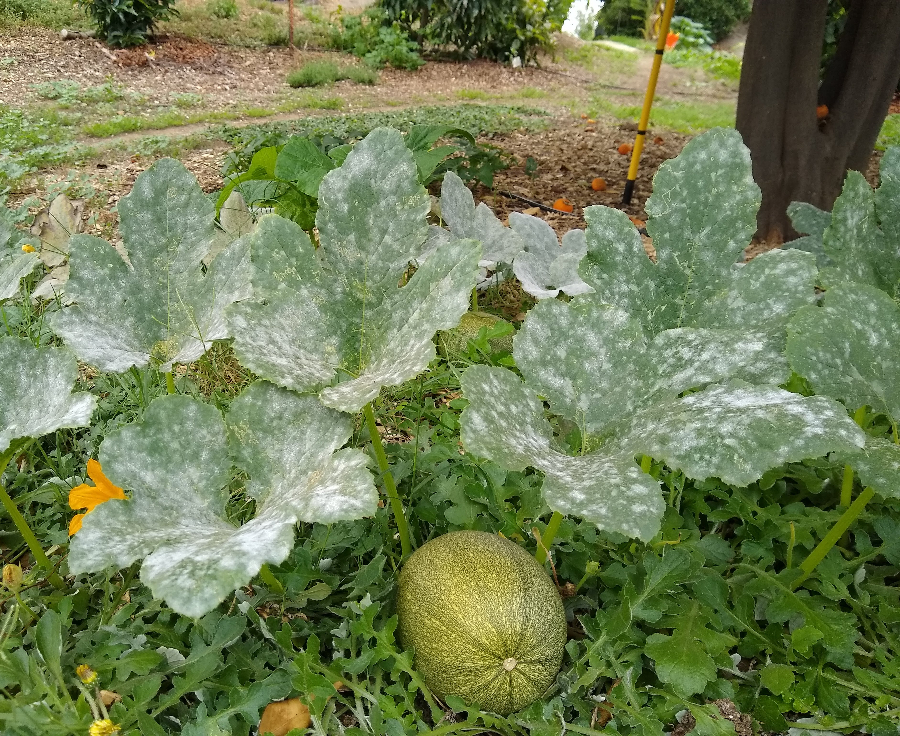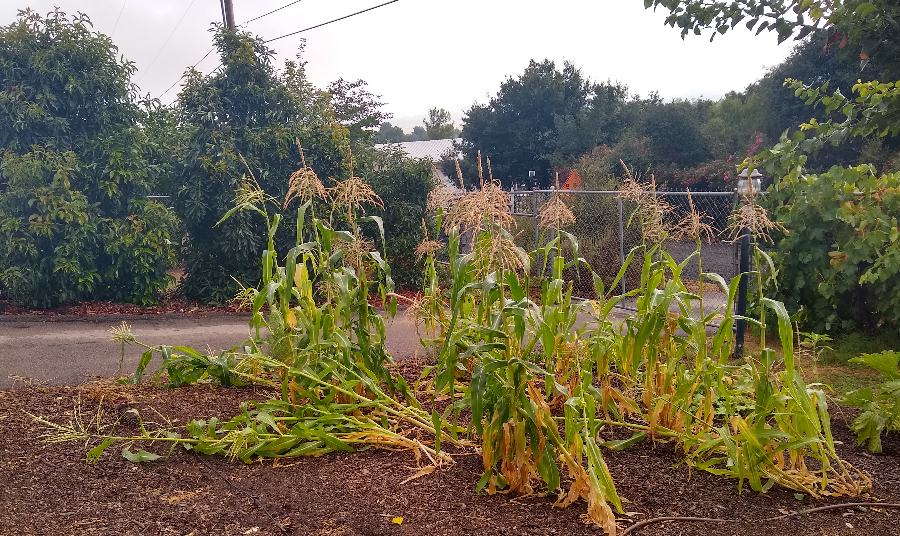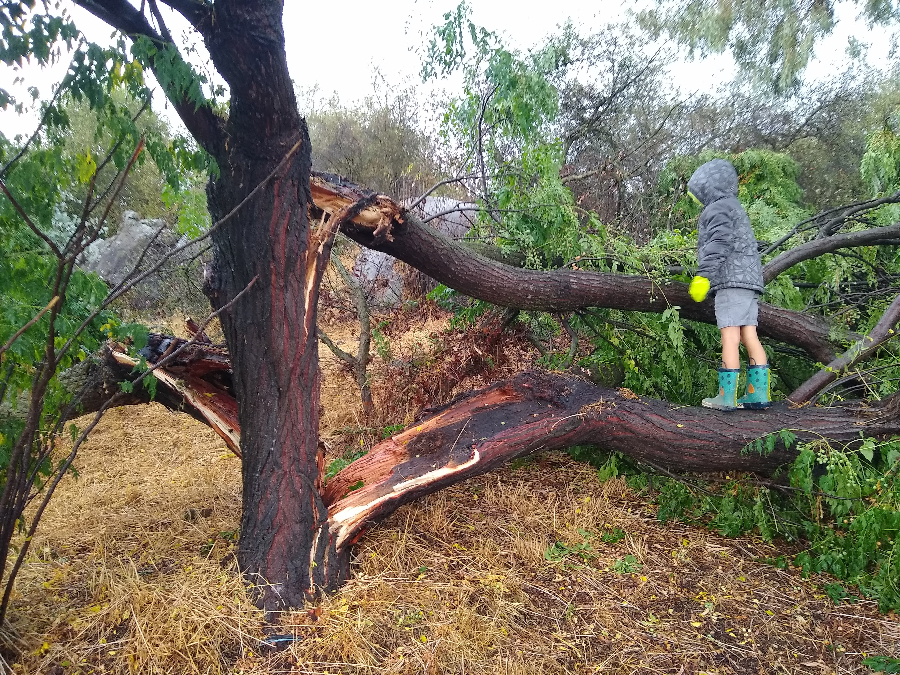Today is the last day of summer. It is sprinkling outside and I’m wearing a sweatshirt. This is not normal.
It has been mostly cloudy for the last couple weeks. And do you remember how long it took for summer weather to begin this year?
The summer season has been concentrated.
Below is how summer 2023 in a Southern California food garden has felt and looked to me. Tell me if you had similar impressions and results.
Temperatures
Let’s talk temperatures first. It’s typical for the beaches to have a gloomy June but at my place, twenty miles from the ocean and up in the foothills in Ramona, I can count on some days in June that are so hot that they burn my apricots.
Last year, 2022, the high temp in June was 104. We reached 102 in June of 2021. We reached 97 as early as June 3 of 2020. We reached 100 on June 10 of 2019.
This June of 2023? It didn’t even reach 90 degrees until the very last day of the month, June 30. Summer arrived late.
As a result, I heard from many gardeners that their early peaches did not sweeten up as much as usual. I don’t grow any early peaches these days, but I found that my mid-season peaches and nectarines ripened later. They tasted good but ripened about three weeks later than usual.
By the calendar, summer runs from about June 20 to September 20 each year. How were the middle months, July and August? They were near normal in terms of temperature.
Inland, we had a few heat waves each month, and they peaked at 103 or 104 at my place, enough to sunburn sensitive things like bell peppers, tomatoes, or young avocado leaves, but not enough to cause serious damage.
Near the beach, it seemed a bit cloudier than normal through July and August, but it was warm enough to grow excellent tomatoes, pumpkins, and watermelon, from what I saw in friends’ gardens there.
But abruptly in the second week of September, the whole of Southern California west of the mountains cooled down. And it hasn’t warmed up again. The sun has barely broken through the clouds on most days in the past two weeks.
On September 16 and 17, my weather station topped out at only 70 and 68. The average high temperatures for these dates are 88 and 87 degrees. The National Weather Service reported that these were daily records for a low maximum temperature at their station nearby on these dates.
In terms of temperature, summer 2023 started late, was near normal in the middle, and ended early.
Humidity
There are a number of wine grape growers near me, and they do not appreciate this cool, cloudy end to summer. They prefer heat in order to build sugars in the grapes.
They also don’t appreciate the humidity that has been with us throughout the summer. Have you noticed higher humidity all summer long?
For grape growers, higher humidity means more mildew. Indeed for all of us, higher humidity means more mildew. I’ve seen slightly more mildew on tomatoes in gardens near the beach, and I’ve had slightly more mildew on my squash and pumpkins this summer.

On the plus side, between the lower overall temperatures this summer and the higher humidity, I’ve been able to water a bit less compared to last summer.
Hurricane Hilary
The rainfall in August from Hurricane Hilary further helped reduce my irrigation needs. On August 20, we received a few gusts of wind that felled a few of my corn plants and 2.5 inches of rain. On the whole, it was a pleasant day of warm precipitation that was preceded by a lot of fearmongering.

Contrast the Hurricane Hilary event with a day two summers ago, August 29, 2021. On that day there was no serious weather in the forecast for my area. But I have a distant view to the east from my house and I saw an unmistakable sign in the sky that afternoon. I have lived where thunderstorms are common. I knew what I was looking at.
Rapidly, black clouds were upon us with rain and wind so strong that it broke a gutter off my roof, threw shade structures across my yard, and knocked down a number of trees including my 30-foot tall Chinaberry.

This reflection makes me laugh: If I had had no access to media and weather forecasts, my memories would be that in August 2021 I experienced a powerful, destructive thunderstorm. Then in August 2023, I experienced an unremarkable but steady summer rain.
What’s in store for the fall?
There’s talk of El Nino, but what relevance does El Nino have for us Southern California food gardeners? (It doesn’t mean rain.)
We usually get some Santa Ana winds in the fall, but who knows? Every season, every year has a surprise in store.
Look at what happened at this time of year in 1939:
“The spring and summer were exceptionally cool and late, there being no hot spells until September. From the 15th to the 23rd of September occurred a hot spell of longest duration and highest temperatures on record. Reversing the usual condition of heat in the interior and coolness along the coast, temperatures on this occasion were highest on the coast, reaching a maximum of 105 degrees at Long Beach and Santa Monica and above 105 at Los Angeles for eight consecutive days. At the close of this period an unforecasted tropical storm came in from the southwest . . . on September 24th and 25th [that] gave from 1.5 inches in San Diego to 5.5 inches in Los Angeles.”
It’s just us here. No ads in between. Thank you for your support of my Yard Posts!
All of my Yard Posts are listed HERE




I [always], enjoy any of your comments or helps regarding Avocado trees.
We live in Fallbrook, so whatever problems with weather, insects, (lack of water), etc. are always welcome by TYP on the net.
My yard problems are (usually) in the avocado area, but this has been a bad year in my yard for vegetable eating rats, mice, and one lonely possum. (I purchased a Catch-em-alive traps and took care of several rats, and one possum. At first we thought it was a squirrel that had invaded, but it wasn’t. No squirrels this year. Chased one baby rabbit from the yard. (the Goldie thought it was a new toy, that we had bought him.) The rabbit is gone for now.
The furete avos and hass are coming to maturity, and I do hope that I don’t have to share the avo crop with the rats, as I did the tomatoes, squash, and cabbages.
I tried the bait, but they don’t like that stuff. (Besides, my wife hates it when I put out bait traps for the rats.
(Two years ago, I think they became immune to the poison baits, so I’ve gone to the large sticky rat traps. Those are great, but costly after a few weeks. There are more rats than glue traps in North County.
Anyways, enough of my folly for one day. Keep on (ministering) to our garden needs.
Blessings to all that like to grow their own….
John, I’m in del Cerro in a gated community with lots of hills and ivy. I have no shortage of rats. I found that having sacrificial fruit helps prevent the rats from wiping out the best fruit. For example I have an early peach which is not very good anyway and the rats start with that which keeps them from eating green tomatoes and apriums. I’m still trying to devise a way to stop the rats eating my citrus leaving just a shell behind.
My experience in Sun City California was similar to yours. I am in zone 9a. July and August were still very hot with many days higher than 103°. Had several days with temperatures above 108°. Then September started warm but cooled down a lot, I called it June Gloom in September. Sunny today either no low clouds.
“Sacrificial fruit,” I think we can all relate. For some reason I got a chuckle out of that! 🤣.
I live in Simi Valley. I had fabulous peaches – I think the best crop since I moved here 4 years ago. I don’t know what variety it is because the tree was here when I moved in, but they are large cling free peaches.
My vegetable garden was a dud, especially the tomatoes. Plants looked good but 3 of them looked stunted and I did not get nearly as many tomatoes as usual. 8 plants and I barely had enough tomatoes for just me! It’s interesting that two other gardeners who are in my neighborhood said the same thing.
Also, my Valencia orange seems mixed up. They are supposed to ripen in summer, right? I have had no oranges since early spring, I think. I have a navel and Valencia tree and had constant oranges from one or the other for the past 4 years, and now nothing for months.
Hi Vickie,
A good peach year is a good year! Just an idea on tomatoes: I would pull up the roots on the stunted ones to check for root knot nematodes. See: https://gregalder.com/yardposts/dealing-with-root-knot-nematodes-in-a-vegetable-garden/
Thanks for your reply Greg. I had no idea about root knot nematodes. I have gotten rid of most of the tomato plants but there is one left that I can check.
I thoroughly enjoy your post. Thank you very much! I’m in Sacramento County and it was super hot this year. My bacon avocado tree only produced 5 this year. It had 4 on one side of the tree and 1 on the other side. All the tiny babies that we saw in the Spring dried up from the heat, which reached 107 a couple of times. One of your followers, Vickie, mentioned her orange tree. Mine is a seedless sweet navel orange and they never ripen until after the Winter frost and well into Spring time. My husband gets on me to pick the rest of them off when the new buds start showing. Is this normally late for oranges to be ready for harvest? Thanks again. We appreciate all your work and time educating us on gardening tips.
Hi D.C.,
Sorry about no Bacons for this year. Hope the tree sets a bunch for you next year.
Your navel orange might just be a late one. There are many varieties of navels these days and all have slightly earlier and later harvest times.
Or you might just like your navel oranges sweet. My main navel is a Cara Cara, and I find that it doesn’t really taste good to me until at least February, but my kids and wife will eat them a bit earlier because they don’t mind them on the tart side.
Hi Greg: A fitting post for a cool summer. I’m in Oceanside and didn’t plant my Tomatoes until May 28 and that may have been early. Most of the summer seemed cooler, more marine layer days. The Momotaro’s did fair but most of my Cherry tomatoes were fabulous. Three weeks ago i planted my last Cherry tomato in a container, hoping i still get some fruit this year. Best to you.
JoeK
Hi Joe,
My best performing tomato plant right now is a cherry. My late-planted, large-fruited types are ripening very slowly now — I suppose because of the shorter days and cooler weather. But the cherry is pumping out tasty little tomatoes. I hope your container one does the same.
Living in San Juan Capistrano we experienced humidity like never before, and I don’t care for it. I do prefer cooler temps, especially when working in the yard, so avoided maintenance for several weeks. I’ve been very happy with the cooler temps this week, making yardwork enjoyable. I have an abundance of figs from my 1 tree, but my 2 plum trees didn’t do well this year.
Hi Laurie,
I remember a couple days out in the yard when my shirt was sticking to me, and I asked myself, “Where do I live? Georgia?”
Hi Greg: By accident or browsing I ran across your u-tube video on “READING AVOCADO LEAVES” . It was exactly what I’m interested in now with a 4 month old severely trimmed Fuerte that has the new reddish/bronze growth. Thank you. You have so much published which isn’t connected. Thank you, I know not anything to do with this summers vegetable post. !! BR. Joe
Hi Joe,
It’s true that I need a better way of organizing my posts and videos to make them easier to find. Let me know if you have ideas.
I search for my own posts often too, and when I do I use the search bar here on the website, or I use the List of all Yard Posts, or I just type into a search engine, “avocado leaves greg alder” or something similar.
Here on the hillside in Whittier, humidity was definitely up this year. Temps were very mild also compared t normal, I think we may have only hit 100F once. I also was able to keep my winter watering schedule the same this whole summer without anything obvious negative consequences. I noticed my Figs ripened a month later than previous years, usually start in early August, but this year late August/early September. I also noticed this year my Bacon/Jim Bacon avocado trees did not get a single Avocado on them, 5 years old each and they had been steadily increasing each year. I believe it was due to the colder spring weather and the lack of bee activity at the time. My only trees that got avocados this year are Hass, Reed, Pinkerton, Lamb Hass and Gem. At the beginning of the year I told my family that was visiting from Ohio that September is always sunny and nice, oh boy was that not true this year, their last two days here it was completely cloudy. Hillary was also a nice steady rain at my vantage point in Whittier. Thank you
Hi Greg – here in coastal Oceanside it feels like we never really had hot sunny days, had to drive to Vista to escape the fog and marine layer. Earlier in the summer, mid June, I planted a specimen grade Hass with 20 or so fruit. Since then, I’ve seen most of the fruit turn black and drop from the tree, even some that are golf ball to baseball sized fruits. There are probably 6-10 healthy looking avocados still on the tree. There has been steady leaf growth on the tree and it seems healthy despite some persea mites and browning tips from salt. It’s hard to tell if this is an act of self pruning, transplant shock, the tree unhappy with the strong winds from Hilary, sunburn, or something else. I’m worried that it’s something systemic because most (not all) of them are turning black. Could this be self pruning or something more sinister?
https://i.imgur.com/dBUA5zX.jpeg
https://i.imgur.com/DWKgdfq.jpg
https://i.imgur.com/mAsxV0s.jpg
By the way, I so appreciate your dedication and diligence to the world of fruit and vegetable gardening in SoCal, you are an invaluable resource to the community and are able to deliver priceless insights in such a digestible way. Thanks for being the “hub” avocado/citrus/vegetable growers all over SoCal.
Cool cool summer here near SDSU. I have often times told my wife that if you want to know what the weather was like in any given season ask a gardener. The news seems to have an agenda to fill. The big bad hurricane knocked over one sugar cane stalk in the garden. We’ve had winter storms that actually toppled trees but this was a great long lasting rain. I got thousands of gallons of water filling my tanks and was out in the garden during the rain. It was a very welcome pleasant surprise.